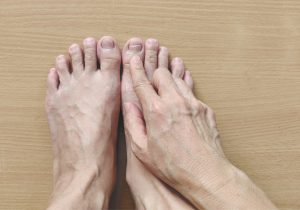By Dr. Lori DeBlasi


Factors contributing to ingrown toenails:
• Improper trimming – cutting your nails too short
• Trauma to the nail – stubbing your toe, having an object fall on your toe or engaging in activities that involve repeated pressure on the toes, such as kicking or running
• Genetic predisposition – the tendency for ingrown toenails is inherited for many
• Poor foot hygiene
• Tight fitting shoes – wearing shoes that are tight or short
• Tight fitting socks – wearing socks that are tight or short
• Fungal nail infections
Presentation:
Mild ingrown toenails present with nail-fold swelling, redness, and pain with pressure to the affected nail. More severe cases can show drainage or extra growth of the nail border that often bleeds. In rare cases, the bone under the nail can get a bone infection requiring IV antibiotic and/or surgery.
Treatment:
Minor ingrown nails can be treated by soaking, placing cotton under the leading edge, trimming, and applying antibiotic creams.
If an ingrown is more severe, with swelling, redness, pus/drainage, or extra skin growth, then an in-office nail procedure is recommended. These do require local anesthesia to perform. An infection will be addressed with an oral antibiotic for 7-10 days. The antibiotic addresses the infection component and does not remove the offending nail border. Typically, the offending border is removed to allow for healing of the border. If there is extra skin growth, this will be removed too. The nail border will grow back out over the course of several months. If a patient gets recurrent ingrown toenails of the same border of the same nail, despite avulsion of the border, a matrixectomy of the border is considered. With a matrixectomy, the nail cells are killed with use of a chemical, either sodium hydroxide or phenol. The result of a matrixectomy is a straight edged side of the nail and a narrowed nail. The offending curved nail border should not grow back.
Homecare for both an avulsion and a matrixectomy consists of soaking and use of a topical antibiotic cream with a bandage until heling occurs. Due to the inflammatory reaction from the chemical, this procedure does take longer to heal than an avulsion.
Prevention of an ingrown toenail:
• Trim your toenails straight across – don’t curve your nails around the edges
• Keep toenails at a moderate length – don’t cut them too short
• Wear shoes that fit properly with a high and wide toe box
• Wear protective footwear – such as steel-toed shoes
• Check your feet – especially if you have Diabetes, poor blood flow or nerve damage to the feet.
Dr. Lori DeBlasi is certified by the American Board of Foot and Ankle Surgery®. Dr. DeBlasi works at Family Foot & Leg Center at the Estero office. She is accepting new patients. To make an appointment, call 239-430-3668 or visit www.NaplesPodiatrist.com.
 Southwest Florida's Health and Wellness Magazine Health and Wellness Articles
Southwest Florida's Health and Wellness Magazine Health and Wellness Articles

